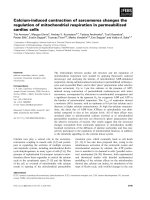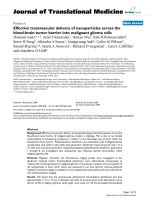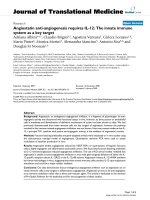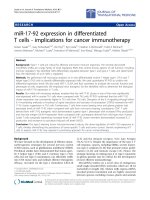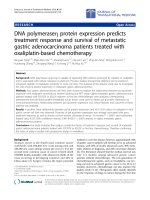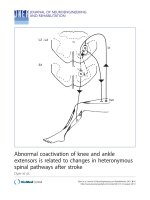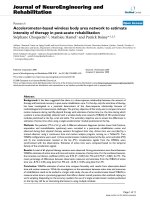báo cáo hóa học:" MUC4 stabilizes HER2 expression and maintains the cancer stem cell population in ovarian cancer cells" ppt
Bạn đang xem bản rút gọn của tài liệu. Xem và tải ngay bản đầy đủ của tài liệu tại đây (976.57 KB, 10 trang )
RESEARC H Open Access
MUC4 stabilizes HER2 expression and maintains
the cancer stem cell population in
ovarian cancer cells
Moorthy P Ponnusamy
1
, Parthasarathy Seshacharyulu
1
, ArokiaPriyanka Vaz
1
, Parama Dey
1
and Surinder K Batra
1,2*
Abstract
Background: Recent evidence has suggested that the capability of cancer to grow, propagate and relapse after
therapy is dependent on a small subset of the cell population within the tumor, called cancer stem cells. Therefore,
this sub population of cells needs to be targeted with different approaches by identification of unique stem-cell
specific target antigens. One of the well known tumor antigens is the epithelial cell mucin MUC4, which is
aberrantly expressed in ovarian cancer as compared to the normal ovary and plays a pivotal role in the
aggressiveness and metastasis of ovarian cancer cells. In the present study, we aimed to analyze the cancer stem
cell population in MUC4 overexpressed ovarian cancer cells.
Methods: MUC4 was ectopically overexpressed in SKOV3 ovarian cancer cells. Western blot analysis was performed
for MUC4, HER2, CD133, ALDH1 and Shh expression in MUC4 overexpressed cells. Confocal analysis of MUC4, HER2
and CD133 was also done in the MUC4 overexpressed cells. CD133 and Hoechst33342 dye staining was used to
analyze the cancer stem cell population via FACS method in SKOV3-MUC4 cells.
Results: MUC4 overexpressed SKOV3 cells showed an increased expression of HER2 compared to control cells.
MUC4 overexpression leads to increased (0.1%) side population (SP) and CD133-positive cancer stem cells
compared to the control cells. Interestingly, the tumor sphere type circular colony formation was observed only in
the MUC4 overexpressed ovarian cancer cells. Furthermore, the cancer stem cell marker CD133 was expressed
along with MUC4 in the isolated circular colonies as analyzed by both confocal and western blot analysis. HER2
and cancer stem cell specific marker ALDH1 along with Shh, a self-renewal marker, showed increased expression in
the isolated circular colonies compared to MUC4-transfected cells.
Conclusion: These studies demonstrate that MUC4 overexpression leads to an enriched ovarian cancer stem cell
population either directly or indirectly through HER2. In future, this study would be helpful for MUC4-directed
therapy for the ovarian cancer stem cell population.
Keywords: MUC4 HER2, CD133, Side Population, Cancer Stem Cells, Ovarian Cancer
Background
Ovarian cancer is a highly lethal disease which represents
a great clinical challenge in gynecologic oncology. It is
asymptomatic until the disease is in the late stage, causing
it to have the highest fatality-to-case ratio of all gynecolo-
gic malignancies. There is emerging evidence showing that
cancer stem cells are capable of regenerating tumor s and
they are responsible for the aggressiveness of the disease,
metastasis and resistance to therapy [1]. Cancer stem cells,
like somatic stem cell s, are thou ght to be capable of self-
renewal or unlimited proliferation. A recent study
describes that ovarian cancer cell lines were shown to pos-
sess “side population” (SP) cells that have been described
as cancer stem cells due to their ability to differentiate
into tumors with different histologies, similar to the pluri-
pot ent character of stem cells [1]. It is now believ ed that
cancer often relapses after the treatment due to the stem-
like population in some solid tumors [2]. Although
* Correspondence:
1
Department of Biochemistry and Molecular Biology, University of Nebraska
Medical Center, Omaha, NE 68198-5870, USA
Full list of author information is available at the end of the article
Ponnusamy et al. Journal of Ovarian Research 2011, 4:7
/>© 2011 Ponnusamy et al; licensee BioMed Central Ltd. This is an Open Acces s article distributed under the terms of the Creative
Commons Attribution License ( which permits unrestricted use, distribution, and
reproduction in any medium, provided the original work is properly cited.
advanced ovarian cancer is generally initially responsive to
standard chemotherapies (cisplatin and paclitaxel), it is
almost inevitably followed by the drug resistant phenotype.
One accepted hypothesis about chemoresistance is t hat
standard therapies fail to target tumor progenitors, which
are like normal stem cells, because of the expression of
membrane efflux transporters [1].
The alterations in the mucin expression or gl ycosyla-
tion pattern is often associated with the development of
cancer via influencing cellular growth, differentiation,
transformation, adhesion, invasion and immunosuppres-
sion [3,4]. MUC4 frequently displays an altered expres-
sion under the pathological conditions of many cancers
[3,4]. Previously, our study has revealed an aberrant
expression of MUC4 mucin in > 90% of different histolo-
gical subtypes and grades of ovarian tumors with very
low or undetectable expression in the normal o vary [5].
Overexpression of MUC4 mRNA has also been reported
in ovarian cancer [6]. In our previous study, we showed
that MUC4 interacts and stab ilizes HER2 in both ovarian
and pancreatic cancer cells [7,8]. We h ave further shown
that MUC4 induces the epithelial to mesenchymal transi-
tion (EMT) through the upregulation of N-cadherin, and
thereby induces metastasis of human ovarian cancer cells
[9]. A recent study has shown that HER2 amplification
regulates the mammary stem/progenitor cell population
and promotes carcinogenesis, tumorigenicity and invasive
properties [10]. Recently, Engelmann et al have demon-
strated that MUC1 (a membrane bound mucin) is also
expressed in the mammary stem/progenitor cells [11]
and is important in the future application of MUC1-
based therapies for complete cancer eradication.
The aforementioned observations suggest that MUC4
may have an important role in the pathogenesis of ovarian
cancer. In this study, we have investigated increased
expression of HER2 and the cancer stem cell population
in MUC4 overexpressed ovarian cancer cells. Further, we
have analyzed cancer stem cell and s elf-renewa l specific
markers in the isolated populations. These studies indicate
that MUC4 induces HER2 expression and may enrich the
cancer stem cell population in ovarian cancer stem cells.
Methods
Generation of MUC4 construct
We generated a MUC4 minigene construct to overcome
the transfection associated problems due to its large size
and to investigate the biological function and effect of
MUC4 expression in OC cells [8,12]. The resultant
MUC4 cDNA was sub-cloned into the pSecTag-C
vector for further transfection studies.
Cell culture and transfection procedure
SKOV3 cells was procured from ATCC (Manassas, VA,
U.S.A.) and cultured in DMEM supplemented with 10%
fetal calf serum and antibiotics. The MUC4 gene construct
along with the empty vector control pSecTag-C, were
transfected in SKOV3 OC cells by Fugene (Invitrogen)
following the m anufacturer’s protocol. Transfecte d cells
were selected in the medium containing 200 μg/ml zeocin
(30 Days) and the drug-resistance (zeo+) clones (three
from the empty vector, five from the MUC4 gene con-
struct transfected) were selected from different plates and
studied after expansion [8,9].
Immunoblot assay
SKOV3 derived cell lines were processed for protein
extraction and Western blotting using standard proce-
dures. Briefly, the cells were washed twice in PBS and
lysate was prepared in RIPA buffer (100 mM Tris,
5 mM EDTA, 5% NP40; pH8.0) containing protease
inhibitors (1 mM phenyl-methyl sulphonyl fluoride,
1 μg/ml aprotinin, 1 μg/ml leupeptin). SDS-PAGE (10%)
was performed under standard conditions. Resolved pro-
teins were transferred on to the PVDF membrane. After
quick washing in PBST (Phosphate buffered saline and
0.1% Tween 20), the membranes were blocked in 5%
nonfat dry milk in PBS for at least 2 h and then incu-
bated with primary antibodies MUC4 (mouse), HER2
(rabbit), ALDH1 ( rabbit), CD133 (rabbit), Shh (rabbit)
and b-actin (mouse) (diluted in 5% non fat dry milk in
PBS) overnight at room temperature. Then the
membranes were washed (3 × 10 min) in PBST at room
temperature and probed with 1:2000 diluted secondary
antibodies (anti-mouse and anti-rabbit) for 1 h at room
temperature and washed 5 × 10 min with PBST. The
signal was detected with an ECL chemiluminescence kit
(Amersham Bioscience, UK).
Confocal immunofluorescence microscopy
MUC4 and vector transfected SKOV3 cells were grown
on sterilized cover slips for 20 h. Cells were washed
with Hanks buffer containing 0.1 M HEPES, and fixed
in ice-cold methanol at 20°C for two minutes and
blocked with 10% goat serum (Jackson Immunoresearch
Labs, Inc., West Grove, PA, U.S.A.) containing 0.05%
Tween-20 fo r at least 30 minutes. For Phalloidin stain-
ing, cells were fixed with 3.6% formaldehyde-PBS solu-
tion and followed by permeabilization with 0.1%
TritonX-100 in PBS for 20 min at room temperature.
After the blocking step and a quick wash in PBS, cells
were incubated with the MUC4, HER2 and CD133 for
60 minutes at room temperature. Then cells were
washed (4 × 5 minutes each washing) with PBS contain-
ing 0.05% Tween-20 (PBS-T) and then incubated with
FITC-conjugated anti-mouse (green) and Texas red con-
jugated anti-rabbit (red) secondary antibodies (Jackson
Immunoresearch labs, Inc., West Grove, PA) for 30
minutes at room temperature in the dark. Propidium
Ponnusamy et al. Journal of Ovarian Research 2011, 4:7
/>Page 2 of 10
iodide was used for nuclear staining. Cells were washed
(5 × 5 minutes) again and m ounted on glass slides in
anti-fade Vectashield mounting medium (Vector Labora-
tories, Burlingame, CA). Laser confocal microscopy was
performed by using a LSM 510 microscope (Carl Zeiss
GmbH, Germany). Microphotographs of different stain-
ings were taken in different channels separately.
Hoechst 33342 dye and CD133 staining for
Flowcytometry analysis
Hoechst 33342 dye based FACS analysis have been used
to determine the SP and NSP population in MUC4
overexpressed and control SKOV3 cells. Cells were
stained with Hoechst 33342 (Sigma) as previously
described [13]. SP cells actively pump-out the dye
(Hoechst 33342) and hence exhibit low fluorescence as
compared to the NSP cells. Briefly, single cell suspen-
sion of OC cells was prepared at a density of 2 × 10
6
/ml
in pre-warmed DMEM mixed with Hoechst 33342 dye
(5 μg/ml). The cells were incubated in water bath at 37°
C for 60 minutes and subsequently spun and re-sus-
pended in cold HBSS+ (Hanks Balanced Salt Solution)
containing 2 μg/ml propidium iodide (PI) for dead cell
discriminatio n. Finally, the samples were run directly on
the FACS and counted according to the strength of
staining. The Hoechst dye was excited with the UV laser
at 350 nm and its fluorescence me asured with a 450/20
BP filter (Hoechst blue) and a 675 EFLP optical filter
(Hoechst red). For the CD133-FITC and FACS analysi s,
2×10
7
cells were incubated with FcR blocking reagent
(MACS, Milteny i Biotech) for 30 minutes. Then it was
incubated with surface marker antibody CD133-FITC
(MACS, Miltenyi Biotech) for 10 minutes. Finally, FACS
analysis was carried out to count CD133-positive popu-
lations in MUC4-transfected and control SKOV3 cells.
Results
Ectopic Expression of MUC4 in SKOV3-Ovarian Cancer
cells
The MUC4 construct developed in our laboratory is
similar to the wild- type MUC4 with 10% repetitive
domain size of its originally described allele [8,9,12].
Expression of MUC4 in stable cell transfectants were
evaluated by Western blot analysis using a MUC4 anti-
body (8G7), which was developed in our laborat ory that
recognizes an epitope in the tandem repeat domain of
MUC4. This antibody recognizes a MUC4 protein band
of approximately 322 kDa specifically in the MUC4 gene
transfected clone (SKOV3-MUC4) and not in the vector
control (SKOV3-Vec) (Figure 1A). Expression and loca-
lization of MUC4 was further confirmed by immuno-
fluorescence confocal microscopy. Ninety percent of the
SKOV3-MUC4 transfected cells showed localization of
MUC4 in both cytoplasm and membranes (Figure 1B)
and an absence of MUC4 localization in vector-trans-
fected SKOV3 cells (Figure 1B).
Overexpression of MUC4 stabilizes HER2 in ovarian
cancer cells
In our previous studies we have shown that MUC4
interacts with HER2 in ovarian cancer and pancreatic
cancer cells [7,8]. In the present study we have ana lyzed
the expression of HER2 in MUC4 overexpressed ovarian
cancer cells. Our result showed that HER2 was upregu-
lated in MUC4 overexpressed SKOV3 cells compared to
the vector control (Figure 1A). Furthermore, we have
analyzed MUC4 and HER2 localization in the same cells
by confocal immunofuorescence analysis. MUC4 and
HER2 were co-localized in MUC4 overexpressed cells,
most of which show an EMT phenotype [9] . Interest-
ingly, a few cells also showed a circular phenotype along
with MUC4-HER2 co-localizat ion (Figure 1B). This sug-
gests that ovarian cancer cells consist of a heteroz ygous
population of cells having different phenotype.
Side population and Non-side population in MUC4
transfected SKOV3 cells
Recently, cancer stem cells have been identified as a minor
population of cells sorted by flow cytometry based on
the ir capacity to efflux the fluorescent DNA-binding dye
Hoechst 33342. This is due to their overexpression of the
ABCG2 drug resistance protein, one of the important
characteristics of cancer stem/progenitor cells [14,15].
This population of cells was termed side population (SP)
and the other population was called the non-side popula-
tion (NSP). In the present study we have analyzed the
number of SP and NSP cells in MUC4-transfected and
control cells. Our results showed that MUC4-transfected
SKOV3 cells were 0.1% more enriched in the SP popula-
tion as compared to the vector control cells (Figure 2A).
This suggests that overexpression of MUC4 leads to
enrichment of the SP population in ovarian cancer cells.
Increased number of CD133-positive cells in MUC4
overexpressed SKOV3 cells
CD133 is a cell surface antigen which was recognized as a
stem cell specific marker for both normal and cancerous
adult tissues. CD133 alone o r along with other markers
are currently used for the isolation of cancer stem
cells from different cancer tissues and cell lines [16,17].
Qverexpressed MUC4 and control cells were stained with
FITC-conjugated CD133 cells to analyze the percentage of
the cancer stem cell population. Interestingly, MUC4-
transfected SKOV3 cells showed a 0.1% increased CD133
population as compared to the control cells (Figure 2B).
This further suggests that overexpression of MUC4 results
in the enrichment of the cancer stem cell population in
ovarian cancer cells.
Ponnusamy et al. Journal of Ovarian Research 2011, 4:7
/>Page 3 of 10
Figure 1 Western blot and confocal analysis of MUC4 and HER2 in SKOV3 cells. (A) Western blot analysis of MUC4 expression and its
derived sub lines SKOV3 Vec (empty vector p-SecTaq) and SKOV3 MUC4. A total of 20 μg protein from cell extracts was resolved by electrophoresis
on a 2% SDS-agarose gel for MUC4 and 10% SDS-PAGE for HER2, transferred to polyvinylidene difluoride membrane, and incubated with anti-
MUC4 monoclonal antibody. The membrane was then probed with horseradish peroxidase-labeled goat anti-mouse immunoglobulin. The signal
was detected using an electrochemiluminescence reagent kit. MUC4 mucin is a high molecular weight glycoprotein and the predicted size of the
mini MUC4 protein is 320 kda. b-actin served as a loading control. (B) Localization of MUC4 and HER2 by confocal microscopy in both the derived
cells. Cells were grown at low density on sterilized cover slips, washed, and fixed in ice-cold methanol at -20°C. After blocking in 10% goat serum,
cells were incubated with the anti-MUC4 mouse monoclonal and anti-HER2 rabbit polyclonal antibodies, washed, and followed by secondary
incubation with FITC-conjugated goat anti-mouse IgG and anti rabbit PI used for nuclear staining (Scale bar-20 μm).
Ponnusamy et al. Journal of Ovarian Research 2011, 4:7
/>Page 4 of 10
Figure 2 Cancer stem cell population analysis in MUC4 overexpressed cells. (A) Hoechest33342 dye analysis showed an incr eased (0.1%)
side population (SP) in SKOV3-MUC4 cells compared to SKOV3-Vector cells. (B) FACS analysis of the CD133-positive population showed an
enriched cancer stem cell population (0.1%) in MUC4-transfected SKOV3 cells compared to vector-transfected cells.
Ponnusamy et al. Journal of Ovarian Research 2011, 4:7
/>Page 5 of 10
Circular colony formation in MUC4-transfected SKOV3
cells
Formation of spherical colonies has been reported to be a
property characteristic of s tem/progenitor cells and veri-
fies a high developmental and proliferative potency of
side population cells [11]. Int erestingly, in our study we
observed circular colony formation in MUC4-transfected
SKOV3 cells when it became over confluent after three
weeks (Figure 3). In contrast, no colony formation was
observed in vector-transfected SKOV3 cells (Figure 3).
We further isolated these colonies for the stem/progeni-
tor marker analysis.
Expression of cancer stem cell and self-renewal markers
in circular colonies
Cancer stem cells express numerous universal markers
such as CD133, CD44, CD24, ESA and ALDH1 in dif-
ferent cancers [1]. Few of these markers were used for
the confirmation of an MUC4 enriched cancer stem cell
populat ion. Stem cells and cancer stem cells are known
to possess the phenomenal property of self-renewal
which is maintained by few specific pathways such as
Shh, Wnt and Notch [1]. The circular colonies or
tumor spheres from MUC4-transfected SKOV3 cells
were isolated and grown in a separate glass cover slip
for the cancer stem cell marker analysis by confocal
microscopy. The confocal results showed imm unofluor-
escence staining of CD133 marker expression (Red)
in the isolated colonies and SKOV3-MUC4 cells (Figure
4A). On the other hand, MUC4 (green) immunofluores-
cence staining is almost equal in both isolated colonies
and SKOV3-MUC4 cells (Figure 4A). In our study we
have also analyzed MUC4, HER2, ALDH1 and CD133
for the cancer stem cells and Shh for the self-renewal
pathway in the isolated colonies from MUC4 overex-
pressed SKOV3 cells and SKOV3-MUC4. MUC4
expression was observed at an almost equal level in
both SKOV3-MUC4 and isolated colonies although
there was a minor molecular weight change in isolated
colonies (F igure 4B). Interestingly, increased expression
of HER2 was seen in isolated colonies compared
to SKOV3-MUC4 cells. Expression of CD133 was also
shown in both SKOV3-MUC4 and isolated colonies,
whereas ALDH1 showed an increased expression in
isolated colonies compared to MUC4 overexpressed
SKOV3 cells (Figure 4B). In addition, the Shh
self-renewal protein expression was observed only in
isolated colonies, while there was no expression in
SKOV3-MUC4 (Figure 4B). This suggests that the iso-
lated colonies from MUC4 overexpressed cells b ehave
like cancer stem cells which are capable of maintaining
the self-renewal property (Figure 5).
Figure 3 Colony formation in MUC4-trasfected cells. SKOV3-Vector and SKOV3-MUC4 cells were seeded in equal confluence and allowed to
grow for up to 18 days. After the full confluence we observed a tumor sphere-like colony formation on the top of the cells. Circular colony
formation was observed only in MUC4 overexpressed SKOV3 cells and no colonies were formed in SKOV3-vector cells. (Original magnification
100X upper panel and 40X lower panel).
Ponnusamy et al. Journal of Ovarian Research 2011, 4:7
/>Page 6 of 10
Figure 4 Expression of cancer stem cell markers in circular colonies. (A) Confocal analysis showed significant expression of CD133 (Red) in
isolated colonies compared to SKOV3-MUC4 cells. MUC4 (Green) expression was seen in both isolated colonies and SKOV3-MUC4 cells. DAPI
(Blue) was used as nuclear counter staining. (B) Western blot analysis showed MUC4, HER2, ALDH1, CD133 and Shh expression in SKOV3-MUC4
and isolated colonies from MUC4 overexpressed SKOV3 cells. b-actin served as a loading control. DIC - differential interference contrast and
staining (Scale bar-20 μm).
Ponnusamy et al. Journal of Ovarian Research 2011, 4:7
/>Page 7 of 10
Discussion
Ovarian cancer is the fourth leading cause of cancer
deaths among all women and has the highest mortality
among the gynecologic cancers. It is one of the most
challenging of all cancers to fight as it often goes
undiagnosed until it has already advanced and metasta-
sized. Furthermore, current therapeutic strategies have
been inefficient and tumor recurrence is observed in up
to 70% of patients with advanced stage ovarian cancer,
even after treatment [18-20]. N umerous evidences have
revealed that a small population of cells behaving like
stem-cells are responsible for the tumor recurrence and
disease aggressiveness [1]. These populatio ns of cells
known as cancer stem cells have been demonstrated to
have roles in many cancers, such as cancers of the
hematopoietic system, ovarian, breast, brain, prostate,
pancreas, colon and liver [1,2,11,13,16,21-25]. To date,
very few specific tumor antigens have been identi fied to
target the cancer stem cell population to pr event tumo r
recurrence. Hence, the present study showed that
MUC4 overexpression is enriching the cancer stem cell
population and it is expressed in stem/progenitor cells
in ovarian cancer cells.
MUC4 is known to be overexpressed in many types of
carcinomas, including ovarian carcinoma [3,5,26]. T he
primary role of MUC4 is to protect the epithelial surface
from injuries under normal physiological conditions, but
overexpression is often correlated with the malignant
phenotype. Our previous s tudy reveals t hat MUC4 i s
aberrantly expr essed in ovarian tumors [5] and in pan-
creatic tumors [3]. Another study from our laboratory
shows that down-regulation of MUC4 is involved in the
suppression of pancreatic tumor cell growt h and metas-
tasis [27]. In our recent study, we have shown a direct
association of the MUC4 mucin with the metastatic
human ovarian cancer phenotype and also provided
experimental evidence for a functional role of MUC4 in
altered growth behavioral properties of the tumor cell
[8]. The ectopic expressed MUC4 gene has all the basic
elements of the MUC4 gene but its tandem repeat
region is only 10% of the wild-type MUC4 allele [8,12].
As predicted, MUC4 overexpressed cells expresse d an
approximately 322 kDa protein. The localization of the
MUC4 protein was observed in both the membrane and
cytoplasm of SKOV3 ovarian cancer cells.
Our previous study demonstrates an altered expres-
sion of the human epidermal growth factor receptor 2
(HER2), also known as ErbB2, in MUC4 overexpressi ng
cells [8]. HER2 belongs to the epidermal growth factor
receptor (EGFR) family. Most membr ane-bound mucins
have juxtamembrane domains with homology to the
members of the EGF family [4]. MUC4 has b een shown
to act as an unorthod ox ligand for Er BB2/HER2 [28],
potentiating its responsiveness in cancer signaling [7,8].
Our recent f inding showed that an overexpression of
MUC4 increases the expression of HER2 in ovarian
cancer cells [8] and stabilizes the HER2 oncoprotein in
pancreatic cancer cells [7]. In the present study, we ana-
lyzed the expression of the HER2 protein in MUC4-
transfected ovarian canc er cells. The exogenous MUC4
expression in ovarian cancer cells showed an increase in
HER2 expression and colocalization, suggesting that
MUC4 is involved in the stabilization of HER2 protein.
There is emerging evide nce that small subpopulations
that behave like stem cells are present in many types of
cancer. These subpopulations are responsible for the
initiation, drug resistance and tumor recurrence [1].
Korkaya and colleagues showed that HER2-overexpres-
sion in b reast cancer cells enriched the cancer stem cell
population, evidenc ed by an increased number of tumor
sphere formation and cancer stem cell marker aldehyde
dehydrogenase expression [10]. They have further
shown an increased expression of stem cell regulatory
genes, increa sed invasion in vitro and increased tumori-
genesis in NOD/SCID mice [10]. This suggests that, in
addition to genetic alterations such as amplification, the
expression of the HER2 level is important for the main-
tenance of CSCs. Recently, a minor population of cells
was isolated by flow cytometry based on their capacity
to efflux the fluoresce nt DNA-binding dye Hoechst
33342 to identify cancer stem cells. This is o ne of the
important properties for cancer stem/progenitor cells
[14,15] because of the e xpression of ABCG2 drug
Figure 5 Schematic representation showed that MUC4
overexpressed ovarian cancer cells induce the aggressiveness
of the cancer cells and enrich the cancer stem cell population.
It also showed that MUC4 is expressed in the ovarian cancer stem
cell population.
Ponnusamy et al. Journal of Ovarian Research 2011, 4:7
/>Page 8 of 10
resistance protein. In our study, we have observed
enriched population of CSCs in MUC4-transfected ovar-
ian cancer cells usin g Hoechst33342 dye and CD133-
positive population analysis. Further, an interesting
observation of tumor sphere like circular colony forma-
tion was observed predominantly in MUC4-transfected
ovarian cancer cells and these colonies were isolated
from the cells and analyzed w ith cancer stem cell mar-
kers. There was a slight change in the mole cular weight
of MUC4 protein in the isolated colonies suggesting
that there may be some variatio n in glycosylation pat-
tern, which will be explored in future studies (Figure
4B). The enriched cancer stem cell population in MUC4
overexpressed cells may be due to the increased expres-
sion of HER2 expression. Furthermore, isolated circular
colonies showed sign ificant expression of cancer stem
cell specific markers CD133 and ALDH1 and the self-
renewal maintenance marker Shh, which concludes that
MUC4 is enriching the cancer stem cell population in
ovarian cancer cells. Similarly, a recent study showed
that a membrane-bound mucin MUC1 maintains a
small population of stem/progenitor cells in the breast
cancer (MCF7) cell lin e [11]. The fact that the vast
majority of MCF7 stem cell enriched SP cells express
MUC1 suggests that epithelial cancer stem cells would
also be the targets of various immunotherapy
approaches based on the MUC1 tumor antigen that has
been designed with mature tumor cells in mind [11].
In conclusion, overexpression of MUC4 induces the
HER2 level and enrichment of cancer stem cells in
MUC4-transfected ovarian cancer cells. Circular colo-
nies isolated from MUC4 overexpressed ovarian cancer
cells show an increased expression of cancer stem cell
specific markers (ALDH1and CD133) and the self-
renewal maker (Shh). This suggests that MUC4 stabi-
lizes HER2 and enriches the cancer stem cell popula-
tion, by either a direct or indirect mechanism which is
yet to be explored. Our study proves that MUC4 is not
only expressed on mature cancer cells, but also on
tumor cells that have multiple characteristics of stem/
progenitor cells (Figure 5). This will help for the future
application of a specific therapeutic target for cancer
stem cells.
Abbreviations
SP: Side Population; NSP: Non-Side Popu lation; CSCs: Cancer stem cells; EMT:
Epithelial to mesenchymal transition; EGFR: Epidermal Growth Factor
Receptor.
Acknowledgements
The authors on this article were supported by grants from the U.S.
Department of Defense (OC04110), National Institutes of Health (RO1
CA78590, CA 131944 and CA133774) and the Susan G. Komen Foundation
(KG070826). The authors acknowledge the invaluable technical support from
Mr. Erik Moore and Mrs. Kavita Mallya. We also thank Janice A. Tayor and
James R. Talaska of the confocal laser scanning microscope core facility at
UNMC, for their support
Author details
1
Department of Biochemistry and Molecular Biology, University of Nebraska
Medical Center, Omaha, NE 68198-5870, USA.
2
Eppley Institute for Research
in Cancer and Allied Diseases, University of Nebraska Medical Center,
Omaha, NE 68198-5870, USA.
Authors’ contributions
All the authors in this manuscript have read and approve the final
manuscript. PPM: Conception and design, collection and/or assembly of
data, data analysis and interpretation, manuscript writing. PS.: Experimental
help and data analysis. AV: Data analysis and manuscript writing. PD.:
Experimental help and manuscript writing. SKB: Conception and design,
financial support, data analysis and interpretation, manuscript writing, and
final approval of manuscript.
Competing interests
The authors declare that they have no competing interests.
Received: 11 March 2011 Accepted: 26 April 2011
Published: 26 April 2011
References
1. Ponnusamy MP, Batra SK: Ovarian cancer: emerging concept on cancer
stem cells. J Ovarian Res 2008, 1:4.
2. Dean M, Fojo T, Bates S: Tumour stem cells and drug resistance. Nat Rev
Cancer 2005, 5:275-284.
3. Andrianifahanana M, Moniaux N, Schmied BM, Ringel J, Friess H,
Hollingsworth MA, Buchler MW, Aubert JP, Batra SK: Mucin (MUC) gene
expression in human pancreatic adenocarcinoma and chronic
pancreatitis: a potential role of MUC4 as a tumor marker of diagnostic
significance. Clin Cancer Res 2001, 7:4033-4040.
4. Hollingsworth MA, Swanson BJ: Mucins in cancer: protection and control
of the cell surface. Nat Rev Cancer 2004, 4 :45-60.
5. Chauhan SC, Singh AP, Ruiz F, Johansson SL, Jain M, Smith LM, Moniaux N,
Batra SK: Aberrant expression of MUC4 in ovarian carcinoma: diagnostic
significance alone and in combination with MUC1 and MUC16 (CA125).
Mod Pathol 2006, 19:1386-1394.
6. Giuntoli RL, Rodriguez GC, Whitaker RS, Dodge R, Voynow JA: Mucin gene
expression in ovarian cancers. Cancer Res 1998, 58:5546-5550.
7. Chaturvedi P, Singh AP, Chakraborty S, Chauhan SC, Bafna S, Meza JL,
Singh PK, Hollingsworth MA, Mehta PP, Batra SK: MUC4 mucin interacts
with and stabilizes the HER2 oncoprotein in human pancreatic cancer
cells. Cancer Res 2008, 68:2065-2070.
8. Ponnusamy MP, Singh AP, Jain M, Chakraborty S, Moniaux N, Batra SK:
MUC4 activates HER2 signalling and enhances the motility of human
ovarian cancer cells. Br J Cancer 2008, 99:520-526.
9. Ponnusamy MP, Lakshmanan I, Jain M, Das S, Chakraborty S, Dey P,
Batra SK: MUC4 mucin-induced epithelial to mesenchymal transition: a
novel mechanism for metastasis of human ovarian cancer cells.
Oncogene 2010, 29:5741-5754.
10. Korkaya H, Paulson A, Iovino F, Wicha MS: HER2 regulates the mammary
stem/progenitor cell population driving tumorigenesis and invasion.
Oncogene 2008, 27:6120-6130.
11. Engelmann K, Shen H, Finn OJ: MCF7 side population cells with
characteristics of cancer stem/progenitor cells express the tumor
antigen MUC1. Cancer Res 2008, 68:2419-2426.
12. Moniaux N, Chaturvedi P, Varshney GC, Meza JL, Rodriguez-Sierra JF,
Aubert JP, Batra SK: Human MUC4 mucin induces ultra-structural changes
and tumorigenicity in pancreatic cancer cells. Br J Cancer 2007,
97:345-357.
13. Szotek PP, Pieretti-Vanmarcke R, Masiakos PT, Dinulescu DM, Connolly D,
Foster R, Dombkowski D, Preffer F, Maclaughlin DT, Donahoe PK: Ovarian
cancer side population defines cells with stem cell-like characteristics
and Mullerian Inhibiting Substance responsiveness. Proc Natl Acad Sci
USA 2006, 103:11154-11159.
14. Bunting KD: ABC transporters as phenotypic markers and functional
regulators of stem cells. Stem Cells
2002, 20:11-20.
Ponnusamy et al. Journal of Ovarian Research 2011, 4:7
/>Page 9 of 10
15. Kim M, Turnquist H, Jackson J, Sgagias M, Yan Y, Gong M, Dean M,
Sharp JG, Cowan K: The multidrug resistance transporter ABCG2 (breast
cancer resistance protein 1) effluxes Hoechst 33342 and is
overexpressed in hematopoietic stem cells. Clin Cancer Res 2002, 8:22-28.
16. Ferrandina G, Bonanno G, Pierelli L, Perillo A, Procoli A, Mariotti A,
Corallo M, Martinelli E, Rutella S, Paglia A, Zannoni G, Mancuso S,
Scambia G: Expression of CD133-1 and CD133-2 in ovarian cancer. Int J
Gynecol Cancer 2008, 18:506-514.
17. Ma S, Lee TK, Zheng BJ, Chan KW, Guan XY: CD133+ HCC cancer stem
cells confer chemoresistance by preferential expression of the Akt/PKB
survival pathway. Oncogene 2008, 27:1749-1758.
18. Auersperg N, Edelson MI, Mok SC, Johnson SW, Hamilton TC: The biology
of ovarian cancer. Semin Oncol 1998, 25:281-304.
19. Jemal A, Siegel R, Ward E, Hao Y, Xu J, Thun MJ: Cancer statistics, 2009. CA
Cancer J Clin 2009, 59:225-249.
20. Wong AS, Auersperg N: Ovarian surface epithelium: family history and
early events in ovarian cancer. Reprod Biol Endocrinol 2003, 1:70.
21. Al-Hajj M, Wicha MS, ito-Hernandez A, Morrison SJ, Clarke MF: Prospective
identification of tumorigenic breast cancer cells. Proc Natl Acad Sci USA
2003, 100:3983-3988.
22. Collins AT, Berry PA, Hyde C, Stower MJ, Maitland NJ: Prospective
identification of tumorigenic prostate cancer stem cells. Cancer Res 2005,
65:10946-10951.
23. Dalerba P, Dylla SJ, Park IK, Liu R, Wang X, Cho RW, Hoey T, Gurney A,
Huang EH, Simeone DM, Shelton AA, Parmiani G, Castelli C, Clarke MF:
Phenotypic characterization of human colorectal cancer stem cells. Proc
Natl Acad Sci USA 2007, 104:10158-10163.
24. Marsden CG, Wright MJ, Pochampally R, Rowan BG: Breast tumor-initiating
cells isolated from patient core biopsies for study of hormone action.
Methods Mol Biol 2009, 590:363-375.
25. Mimeault M, Hauke R, Mehta PP, Batra SK: Recent advances in cancer
stem/progenitor cell research: therapeutic implications for overcoming
resistance to the most aggressive cancers. J Cell Mol Med 2007,
11:981-1011.
26. Boman F, Buisine MP, Wacrenier A, Querleu D, Aubert JP, Porchet N: Mucin
gene transcripts in benign and borderline mucinous tumours of the
ovary: an in situ hybridization study. J Pathol 2001, 193:339-344.
27. Singh AP, Moniaux N, Chauhan SC, Meza JL, Batra SK: Inhibition of MUC4
expression suppresses pancreatic tumor cell growth and metastasis.
Cancer Res 2004, 64:622-630.
28. Ramsauer VP, Pino V, Farooq A, Carothers Carraway CA, Salas PJ,
Carraway KL: Muc4-ErbB2 complex formation and signaling in polarized
CACO-2 epithelial cells indicate that Muc4 acts as an unorthodox ligand
for ErbB2. Mol Biol Cell 2006, 17
:2931-2941.
doi:10.1186/1757-2215-4-7
Cite this article as: Ponnusamy et al.: MUC4 stabilizes HER2 expression
and maintains the cancer stem cell population in ovarian cancer cells.
Journal of Ov arian Research 2011 4:7.
Submit your next manuscript to BioMed Central
and take full advantage of:
• Convenient online submission
• Thorough peer review
• No space constraints or color figure charges
• Immediate publication on acceptance
• Inclusion in PubMed, CAS, Scopus and Google Scholar
• Research which is freely available for redistribution
Submit your manuscript at
www.biomedcentral.com/submit
Ponnusamy et al. Journal of Ovarian Research 2011, 4:7
/>Page 10 of 10

